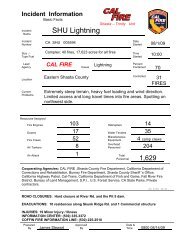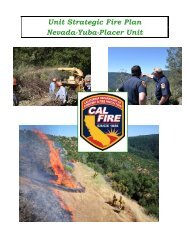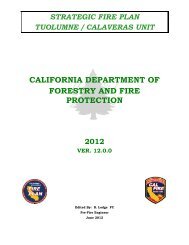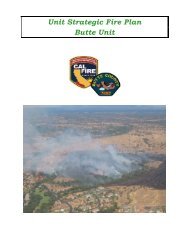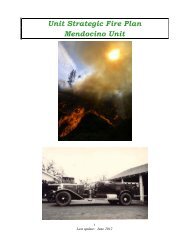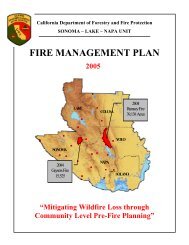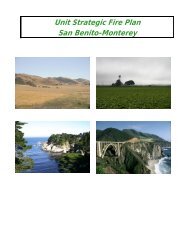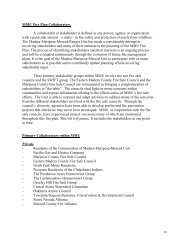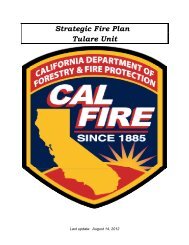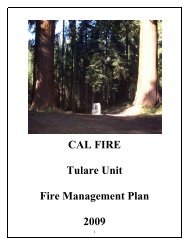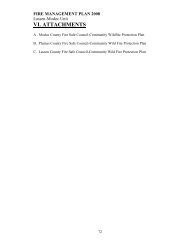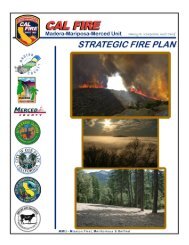Nevada-Yuba-Placer Strategic Fire Plan 2011 - Board of Forestry ...
Nevada-Yuba-Placer Strategic Fire Plan 2011 - Board of Forestry ...
Nevada-Yuba-Placer Strategic Fire Plan 2011 - Board of Forestry ...
You also want an ePaper? Increase the reach of your titles
YUMPU automatically turns print PDFs into web optimized ePapers that Google loves.
EXECUTIVE SUMMARY<br />
Executive Summary<br />
The <strong>Nevada</strong>-<strong>Yuba</strong>-<strong>Placer</strong> Unit (NEU) <strong>Fire</strong> Management <strong>Plan</strong> is a product <strong>of</strong> the implementation<br />
<strong>of</strong> the State <strong>Fire</strong> <strong>Plan</strong>. The State <strong>Fire</strong> <strong>Plan</strong> provides an analysis procedure utilizing, in part,<br />
computer based geographical information data that is validated by experienced fire managers to<br />
assess fire fuel hazards and risks in order to design and implement mitigating activities. The<br />
NEU <strong>Fire</strong> Management <strong>Plan</strong> provides background information, fuels and fire data, proposed<br />
projects, and individual Battalion reports outlining mitigating activities commonly carried out<br />
each year. The NEU <strong>Fire</strong> Management <strong>Plan</strong> is our local road map to create and maintain<br />
defensible landscapes in order to protect those assets vital to the state.<br />
NEU is one <strong>of</strong> 21 administrative Units within the California Department <strong>of</strong> <strong>Forestry</strong> and <strong>Fire</strong><br />
Protection. NEU faces many challenges, not the least <strong>of</strong> which is two <strong>of</strong> its counties, <strong>Placer</strong> and<br />
<strong>Nevada</strong>, are two <strong>of</strong> the fastest growing counties within the state. Many <strong>of</strong> the people moving to<br />
these mid Sierra <strong>Nevada</strong> rural counties are coming from urban areas such as the San Francisco<br />
Bay, Los Angeles, and Sacramento. This leads to the urbanization <strong>of</strong> fire adapted vegetation<br />
types and ecosystems.<br />
A big challenge facing NEU is one <strong>of</strong> education. Most <strong>of</strong> the new residents, and many <strong>of</strong> the<br />
existing ones realize what building houses in the middle <strong>of</strong> fire adapted ecosystems means. The<br />
fire adapted forest types where most <strong>of</strong> the population exists within NEU are Mixed Conifer,<br />
Ponderosa/Shrub, Montane Chaparral, and California Oak Woodlands. Research shows that<br />
prior to European settlement, fire return intervals ranged from 2 to 8 years in California Oak<br />
Woodlands and 5 to 16 years in the remaining forest types. This equated to low intensity fires at<br />
frequent intervals. As <strong>of</strong> 1900 to 1920, wildfires have been suppressed in these vegetation<br />
types. As a result, over the last 80 - 100 years vegetative fuels have increased significantly in<br />
tons per acre. Unnaturally high fuel loads have resulted. But, most <strong>of</strong> the public does not realize<br />
this, nor do they understand what this means in terms <strong>of</strong> fire intensity and their safety. They<br />
have come to believe what they see now is “natural.”<br />
Wildfires in these unnatural fuel load conditions are very intense and more difficult to suppress.<br />
Overlay the mix <strong>of</strong> homes and personal property in these areas and suppression is even more<br />
difficult. The task at hand is to educate the citizens within these areas as to the dangers <strong>of</strong> living<br />
in these fuels and to induce the public into taking an active role in becoming an informed and<br />
appropriate land steward and taking it upon themselves to manage the fuels around their<br />
structures. Creating “defensible space” around these structures is the single best thing a<br />
resident can accomplish to protect their property. Secondary to the effort <strong>of</strong> creating the<br />
defensible space around their homes is a landowner’s responsibility to apply his or her<br />
stewardship responsibility across their entire ownership. The overall effect <strong>of</strong> each property<br />
owner properly managing wildland fuels results in a landscape level fuel reduction and a<br />
commensurate reduction in fire intensity. Once this is achieved, the goal <strong>of</strong> reducing costs and<br />
losses to human lives, property and natural resources will be reached.<br />
Priorities and Goals<br />
The State <strong>Board</strong> <strong>of</strong> <strong>Forestry</strong> and the California Department <strong>of</strong> <strong>Forestry</strong> and <strong>Fire</strong> Protection have<br />
drafted a comprehensive update <strong>of</strong> the <strong>Fire</strong> <strong>Plan</strong> for wildland fire protection in California. NEU<br />
has reviewed the 2010 <strong>Strategic</strong> <strong>Fire</strong> <strong>Plan</strong> (State) goals in order to develop and incorporate<br />
those goals into the Unit <strong>Fire</strong> Management <strong>Plan</strong>. The NEU priorities provide the foundation<br />
upon which our local goals and objects are built. The NEU priorities and Goals are as follows:<br />
- 3 –



